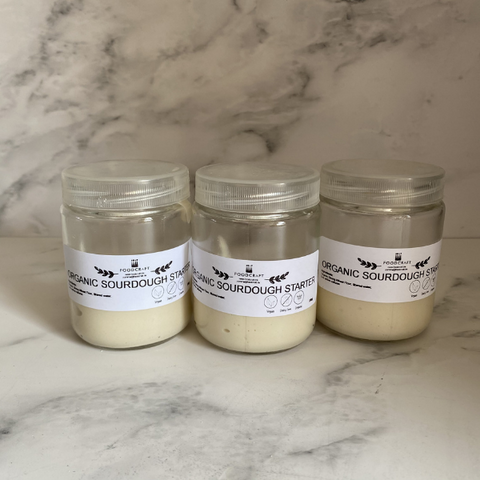
How to use SOURDOUGH STARTER to make the softest and most delicious bread!
How to use SOURDOUGH STARTER to make the softest and most delicious bread!
New to baking? Or is it the first-time making sourdough bread?
We know that there is a certain degree of difficulty in cultivating a perfect sourdough starter, so we are sharing this with you today, so that you can bake soft and tasty bread at home!
What is a “sourdough starter”?

The starter is basically fermented flour and water mixed together. So how does that work in your bread making process?
"Wild yeast" is basically the natural bacteria in the air, they help to convert the grain’s natural sugar and starch in the flour into carbon dioxide-this will create those beautiful air pockets to make the dough rise! In addition, they also help convert the gluten in wheat into lactic acid, giving the sourdough a unique rich flavour.
Once the flour and water are fed to the starter and it becomes bubbly, the fermentation process will begin. You should see the starter begin to bubble and expand. But people usually struggle to maintain the traditional fermentation method, so the bread does not rise well or can taste a little off.
This is why we share this method with you, so that you can clearly understand how to cultivate healthy and perfect sourdough starter. Before we start, it is very important to understand some basic information about the fermentation process...
Your starters will go through the cycle stages of rising, peaking and sinking after every feed, but the time will be different. It is very important for you to understand the meaning of each stage.
When you receive our sourdough starter 👇🏻👇🏻👇🏻

Rising stage 👇🏻👇🏻👇🏻

Peaking stage 👇🏻👇🏻👇🏻

It is not ideal to use the rising “young” sourdough starter to make bread because the fermentation has not been completed. Nor even a starter that has gone through the cycle and has deflated and hungry.
When is the ideal time to use starter?
When the starter reaches its "peak period", it will expand to twice or more of its original size. This means the starter have reached a fully fermented state! This peak period will last for several hours only, and it will have a slight sour and vinegar taste. Don't panic, this yeast smell is completely normal and you can use it with confidence. Then comes the "sinking" stage...
It can still be used! This is also a good time to re-train starters. At this stage your starters will have a very sour or even slight alcohol smell (ethanol smell), which just means it is time to feed the starter again!
When you receive our sourdough starter, it is likely to be in the "sinking" stage, which means it should be fed.
The fermentation speed will be affected by these factors:
• Temperature: high temperature - faster fermentation, low temperature-slower fermentation
• Remaining amount: more starter - faster fermentation, less starter - slower fermentation
• Flour type: Not all flours ferments at the same rate. Our Sprouted Spelt Flour is easier to ferment than high-gluten flour. You can use the flour on hand to see what is difference.
How to feed your sourdough starter There are many ways to do this, but here we will share our methods!
1. Let your starter ferment to the "sinking" stage
2. Throw away half of the portion-you can use it in your baking, or if baking is not planned, you can throw it into the compost bin. At this stage, about 20-40 grams of starter should be left.
3. Use the remaining half to add about 30 grams of flour and 30 grams of filtered water. The flour can be your favorite flour mix or an ordinary high-gluten flour.
4. After mixing them, put the lid on the container (not tightly closed) and let it go through the cycle stage again (as above). Note: The starter we deliver are packed in sealed containers to prevent any insects or dust from flying in.
How to preserve your sourdough starter
You can put your starter in the refrigerator for up to 7 days without feeding. When preparing to bake, please feed the starter to the above-mentioned feeding step (at room temperature) before starting to bake.
If you will be out for more than 10 days (for travel, business, etc.), you can put the starter in the freezer. When preparing to bake, first put the starter at room temperature to thaw and proceed to the feeding step. It may be necessary to repeat this step 2-3 times until the starters are fully activated. Hope these stepss can help you bake the best sourdough bread!
By the way, we have 3 different types of sourdough starters.
If you have any questions, please contact us, we are happy to answer your questions!
